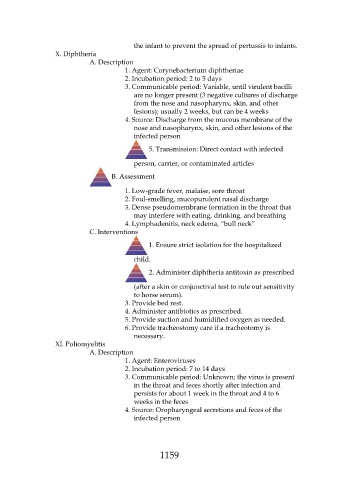Page 1159 - Saunders Comprehensive Review For NCLEX-RN
P. 1159
the infant to prevent the spread of pertussis to infants.
X. Diphtheria
A. Description
1. Agent: Corynebacterium diphtheriae
2. Incubation period: 2 to 5 days
3. Communicable period: Variable, until virulent bacilli
are no longer present (3 negative cultures of discharge
from the nose and nasopharynx, skin, and other
lesions); usually 2 weeks, but can be 4 weeks
4. Source: Discharge from the mucous membrane of the
nose and nasopharynx, skin, and other lesions of the
infected person
5. Transmission: Direct contact with infected
person, carrier, or contaminated articles
B. Assessment
1. Low-grade fever, malaise, sore throat
2. Foul-smelling, mucopurulent nasal discharge
3. Dense pseudomembrane formation in the throat that
may interfere with eating, drinking, and breathing
4. Lymphadenitis, neck edema, “bull neck”
C. Interventions
1. Ensure strict isolation for the hospitalized
child.
2. Administer diphtheria antitoxin as prescribed
(after a skin or conjunctival test to rule out sensitivity
to horse serum).
3. Provide bed rest.
4. Administer antibiotics as prescribed.
5. Provide suction and humidified oxygen as needed.
6. Provide tracheostomy care if a tracheotomy is
necessary.
XI. Poliomyelitis
A. Description
1. Agent: Enteroviruses
2. Incubation period: 7 to 14 days
3. Communicable period: Unknown; the virus is present
in the throat and feces shortly after infection and
persists for about 1 week in the throat and 4 to 6
weeks in the feces
4. Source: Oropharyngeal secretions and feces of the
infected person
1159

